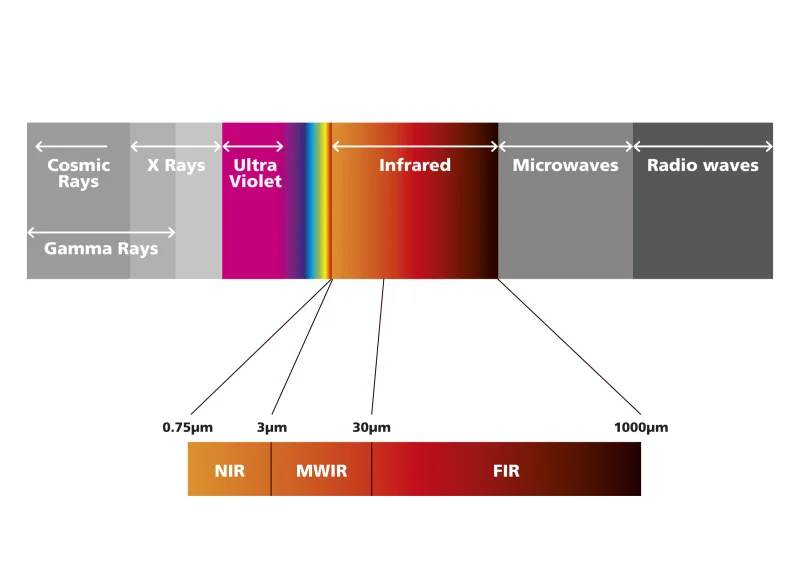What Is infrared radiation?
Infrared radiation is a form of energy that surrounds our everyday lives, even if we cannot see it directly. Sitting just beyond the red edge of the visible spectrum, infrared spans wavelengths from about 700 nanometres (nm) to 1,000,000 nm. Unlike visible light, infrared is experienced chiefly as warmth—whether from sunlight, a heated floor, or even a living being.
Infrared radiation forms part of the electromagnetic spectrum and is divided into three main segments:
- Near-infrared (NIR): 700–2,500 nm, bordering visible light and commonly exploited for technology and imaging.
- Mid-infrared (MIR): 2,500–50,000 nm, often associated with chemical analysis and environmental sensing.
- Far-infrared (FIR): 50,000–1,000,000 nm, linked closely to deep heat applications and climate studies.
All objects warmer than absolute zero emit infrared radiation; the hotter something is, the more infrared it produces. Humans don’t see these wavelengths, but our skin perceives them as heat.

The infrared spectrum and where it sits within the electromagnetic spectrum.
Everyday uses of infrared radiation
Infrared’s versatility arises from how its wavelengths interact with materials, living tissues, and the environment. Here’s how different industries put this energy to work, with specified wavelength ranges to show where each application fits.
Healthcare and therapies
- FIR (50,000–1,000,000 nm): Used in heated wellness devices, rehabilitation lamps, and physiotherapy for deep tissue heat and circulation improvement.
- NIR (700–2,500 nm): Non-invasive imaging tools employ NIR to study skin layers, pinpoint abnormal blood flow, and guide precise treatments.
- Thermal Imaging (9,000–14,000 nm): Monitoring temperature variance assists in fever screening, wound evaluation, and circulatory assessments.
Security and surveillance
- NIR (700–1,400 nm): Night-vision and infrared cameras allow unobtrusive monitoring in dark or smoky environments. LiDAR (Light Detection and Ranging) measures distance and maps objects and environments, for example in automotive driver assistance systems. Biometric security systems also use NIR for facial and fingerprint identification.
- SWIR (900–1,700 nm): Specialized cameras see through environmental obscurants like fog, supporting military and emergency services.
Communication technologies
- Fibre optics (850, 1,310, 1,550 nm): High-speed internet and data flow in homes and data centres are made possible by fibres that transmit infrared light at these select bands. Each wavelength supports optimal transmission over varying distances, with 1,550 nm preferred for minimal loss.
- Free-space optical (FSO) communications (1,550 nm, plus 780–1,600 nm): Wireless, high-bandwidth connections—such as satellite, building-to-building, and experimental ground-air systems—transmit secure data using NIR lasers.
- Data centres: Links between servers, racks, and inter-site connections all rely on these key NIR wavelengths for speed and reliability.
Precision measurement and testing
- Laser rangefinders (905 nm, 1,550 nm): Devices that measure distance with pinpoint accuracy benefit from these wavelengths for both safety and effectiveness. The 905 nm band is typical in consumer gear, while 1,550 nm excels in specialized and military systems.
- Optical fibre testers (850, 1,310, 1,550 nm): Tools that diagnose network problems or guarantee installation quality operate in these established communication bands.
Astronomy and scientific exploration
- 700–50,000 nm: Infrared telescopes track hidden star nurseries and dusty galaxies, overcoming visible-light limitations.
- SWIR (1,220–2,190 nm): Offers astronomers unique views beyond atmospheric disturbance for deep-space observation.
Industrial and environmental applications
- Thermal cameras (9,000–14,000 nm): Used by engineers and energy managers to diagnose heat leaks, electrical faults, or inefficient insulation.
- Remote temperature sensors (4,500–50,000 nm): Essential for safe machine operation and process monitoring.
Farming and nature monitoring
- NIR (750–2,500 nm): Drones and satellites check plant health, map irrigation needs, and forecast yields by measuring specific leaf reflectance.
- Red edge (680–750 nm): This slim band distinguishes plant species and identifies stressed crops.
- MIR (4,500–50,000 nm): Climate models and meteorological satellites use these wavelengths to track global changes, atmospheric temperatures, and water cycles.
The significance of infrared
From invisible data highways in fibre optics to the warmth in physiotherapy lamps and the precision of laser rangefinders, infrared excels in roles where visible light simply cannot compete. Far beyond providing heat, it drives advances in medicine, security, science, industry, and environmental monitoring. The energy veiled just past the red border of our vision is, in fact, a backbone of technology, delivering benefits from 700 nm all the way up to 1,000,000 nm and shaping how people interact with the world around them.
Phlux Technology and SWIR sensors
Phlux Technology has developed avalanche photodiode (APD) NIR sensors that are 12x more sensitive than traditional devices used in this waveband. Optimised for SWIR communications and measurement technologies, you can find out more about them here.